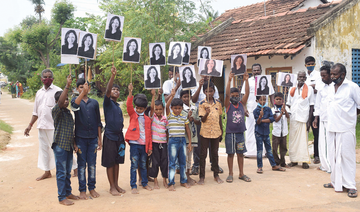NEW DELHI: US Vice President-elect Kamala Harris has made history by becoming the first woman, and female black American and Asian American to be elected to the second-highest office in America.
And women in her ancestral village and throughout India on Wednesday revealed how they had been “inspired” by the 56-year-old politician.
Some made colorful rangoli designs outside their houses, while others distributed sweets among residents of Thulasenthirapuram village, in the southern Indian state of Tamil Nadu, to celebrate the success of “one of their own.”
Meethavi Gopalan, a teacher from the nearby town of Mannargudi, told Arab News: “Kamala Harris belongs to this village (Thulasenthirapuram) as her ancestors lived here. We feel inspired by her success. This is a great moment for us in the area and also as a woman.”
The sleepy village of Thulasenthirapuram, in Nagapattinam district, came to life on Sunday after American news networks declared Joe Biden and Harris as the winner of the US elections.
Soon, women from nearby areas made a beeline to the village temple to partake in festivities. Leading the initiative was local councilor Arulamozli Sudhakar who organized the celebratory events.
“We are very proud of her as she is the first woman vice president of the United States,” she told Arab News.
A high school dropout, Sudhakar, 35, said Harris’ win had motivated her to pursue higher studies. “I am courageous now after Kamala’s victory. Not only am I going to pursue my degree now, but I am also thinking of fighting for elections in the regional and national assemblies.”
She added that several women in the village who had left their jobs to focus on their domestic lives also “wanted to pursue their interests and be productive members of society. Harris has made us realize that nothing is impossible for girls or women.”
Harris was born in the US to an Indian mother and a Jamaican father – both of whom had migrated to America to study.
But despite her mother’s death from cancer in 2009, Harris continued to keep in touch and foster strong relationships with India and her relatives.
She was five years old when she last visited Thulasenthirapuram, and in her autobiography, “The Truths We Hold: An American Journey,” she talks about walking along Chennai’s beaches with her grandfather.
As a senator, Harris has been a vocal advocate of women, human, and minority rights – an endorsement welcomed by many women working for rights groups in India who said they felt “a sense of relief with Harris’ election.”
Jameela Nishat, a women’s rights activist from the southern Indian city of Hyderabad, told Arab News: “I had been watching the US election very closely and with lots of hope this time. The moment I came to know that Harris’ party had won the verdict I felt a great sense of relief and joy.”
“The atmosphere in the country has become so suffocating with the way the government is going after minority and rights activists that it had become difficult to breathe. In Harris, we see hope, someone who can listen to our voice.”
Harris’ Delhi-based maternal uncle, Balachandran Gopalan, said that human and women’s rights would now “get the focus that they deserve.”
“There is no point comparing the democratic regime with the (President Donald) Trump one; the new government will be better in every respect not only in human rights,” he told Arab News. “I feel the new administration’s response to some of the things happening in India would be different from Trump’s regime.”
Biden and Harris have both been critical of the treatment of India’s Muslim minority by the country’s ruling Bharatiya Janata Party (BJP) and the political marginalization of Kashmiris after the abrogation of the special autonomous status of Jammu and Kashmir by New Delhi last year.
Delhi-based research scholar and activist, Zikra Mojibi, has criticized the Citizenship Amendment Act (CAA), legislation which extends citizenship to Hindus, Sikhs, Parsis, Jains, Christians, and Buddhists from neighboring Bangladesh, Pakistan, and Afghanistan, but excluded Muslims.
“Harris is a new ray of hope for the minorities. She has always been looked up to. Now that she is in a position of power, hopefully, the minorities’ voice will be heard in much better ways,” Mojibi said.





















